Rheological Performance of Magnetorheological Grease with Embedded Graphite Additives
Abstract
1. Introduction
2. Methodology
2.1. Sample Preparation
2.2. Sample Characterization
3. Results
3.1. ESEM Characterization
3.2. Effect of Graphite on MRG under Rotational Mode
3.3. Effect of Graphite on MRG under Oscillatory Mode
4. Conclusions
Author Contributions
Funding
Institutional Review Board Statement
Informed Consent Statement
Data Availability Statement
Acknowledgments
Conflicts of Interest
References
- Ahamed, R.; Choi, S.B.; Ferdaus, M.M. A State of Art on Magneto-Rheological Materials and Their Potential Applications. J. Intell. Mater. Syst. Struct. 2018, 29, 2051–2095. [Google Scholar] [CrossRef]
- Kumar, J.S.; Paul, P.S.; Raghunathan, G.; Alex, D.G. A Review of Challenges and Solutions in the Preparation and Use of Magnetorheological Fluids. Int. J. Mech. Mater. Eng. 2019, 14, 13. [Google Scholar] [CrossRef]
- Park, J.H.; Kwon, M.H.; Park, O.O. Rheological Properties and Stability of Magnetorheological Fluids Using Viscoelastic Medium and Nanoadditives. Korean J. Chem. Eng. 2001, 18, 580–585. [Google Scholar] [CrossRef]
- Rankin, P.J.; Horvath, A.T.; Klingenberg, D.J. Magnetorheology in Viscoplastic Media. Rheol. Acta 1999, 38, 471–477. [Google Scholar] [CrossRef]
- Karis, T.E.; Kono, R.N.; Jhon, M.S. Harmonic Analysis in Grease Rheology. J. Appl. Polym. Sci. 2003, 90, 334–343. [Google Scholar] [CrossRef]
- Wang, H.; Li, Y.; Zhang, G.; Wang, J. Effect of Temperature on Rheological Properties of Lithium-Based Magnetorheological Grease. Smart Mater. Struct. 2019, 28, 035002. [Google Scholar] [CrossRef]
- Mohamad, N.; Mazlan, S.A.; Ubaidillah; Choi, S.B.; Nordin, M.F.M. The Field-Dependent Rheological Properties of Magnetorheological Grease Based on Carbonyl-Iron-Particles. Smart Mater. Struct. 2016, 25, 095043. [Google Scholar] [CrossRef]
- Burhannuddin, N.L.; Nordin, N.A.; Mazlan, S.A.; Aziz, S.A.A.; Kuwano, N.; Jamari, S.K.M.; Ubaidillah. Physicochemical Characterization and Rheological Properties of Magnetic Elastomers Containing Different Shapes of Corroded Carbonyl Iron Particles. Sci. Rep. 2021, 11, 868. [Google Scholar] [CrossRef]
- Sahin, H.; Gordaninejad, F.; Wang, X.; Fuchs, A. Rheological Behavior of Magneto-Rheological Grease (MRG). In SPIE 6525, Active and Passive Smart Structures and Integrated Systems; SPIE: Bellingham, WA, USA, 2007; Volume 6525, p. 65250D. [Google Scholar] [CrossRef]
- Sukhwani, V.K.; Hirani, H. A Comparative Study of Magnetorheological-Fluid-Brake and Magnetorheological-Grease-Brake. Tribol. Online 2008, 3, 31–35. [Google Scholar] [CrossRef]
- Kim, J.E.; Ko, J.D.; Liu, Y.D.; Kim, I.G.; Choi, H.J. Effect of Medium Oil on Magnetorheology of Soft Carbonyl Iron Particles. IEEE Trans. Magn. 2012, 48, 3442–3445. [Google Scholar] [CrossRef]
- Mohamad, N.; Rosli, M.A.; Abdul Aziz, S.A.; Mazlan, S.A.; Ubaidillah, U.; Nordin, N.A.; Yahaya, H.; Abd Fatah, A.Y. Intrinsic Apparent Viscosity and Rheological Properties of Magnetorheological Grease with Dilution Oils. In Lecture Notes in Mechanical Engineering, Proceedings of the 6th International Conference and Exhibition on Sustainable Energy and Advanced Materials, Surakarta, Indonesia, 16–17 October 2019; Sabino, U., Imaduddin, F., Prabowo, A., Eds.; Springer: Singapore, 2020; pp. 171–180. [Google Scholar] [CrossRef]
- Wang, K.; Dong, X.; Li, J.; Shi, K.; Li, K. Effects of Silicone Oil Viscosity and Carbonyl Iron Particleweight Fraction and Size on Yield Stress for Magnetorheological Grease Based on a New Preparation Technique. Materials 2019, 12, 1778. [Google Scholar] [CrossRef]
- Mohamad, N.; Ubaidillah; Mazlan, S.A.; Choi, S.B.; Halim, N.A. Improvement of Magnetorheological Greases with Superparamagnetic Nanoparticles. MATEC Web Conf. 2018, 159, 8–12. [Google Scholar] [CrossRef][Green Version]
- Tarmizi, S.M.A.; Nordin, N.A.; Mazlan, S.A.; Mohamad, N.; Rahman, H.A.; Aziz, S.A.A.; Nazmi, N.; Azmi, M.A. Incorporation of Cobalt Ferrite on the Field Dependent Performances of Magnetorheological Grease. J. Mater. Res. Technol. 2020, 9, 15566–15574. [Google Scholar] [CrossRef]
- Tian, T.F.; Li, W.H.; Alici, G.; Du, H.; Deng, Y.M. Microstructure and Magnetorheology of Graphite-Based MR Elastomers. Rheol. Acta 2011, 50, 825–836. [Google Scholar] [CrossRef]
- Shabdin, M.K.; Rahman, M.A.A.; Mazlan, S.A.; Ubaidillah; Hapipi, N.M.; Adiputra, D.; Aziz, S.A.A.; Bahiuddin, I.; Choi, S.B. Material Characterizations of Gr-Based Magnetorheological Elastomer for Possible Sensor Applications: Rheological and Resistivity Properties. Materials 2019, 12, 391. [Google Scholar] [CrossRef]
- Pang, H.; Xuan, S.; Liu, T.; Gong, X. Magnetic Field Dependent Electro-Conductivity of the Graphite Doped Magnetorheological Plastomers. Soft Matter 2015, 11, 6893–6902. [Google Scholar] [CrossRef]
- Thakur, M.K. Influence of Graphite Flakes on the Strength of Magnetorheological Fluids at High Temperature and Its Rheology. IEEE Trans. Magn. 2020, 56, 4600210. [Google Scholar] [CrossRef]
- Radouane, N.; Maaroufi, A.; Ouaki, B.; Poupin, C.; Cousin, R.; Duponchel, B.; Singh, D.P.; Hadj-Sahraoui, A.; Depriester, M. Thermal, Electrical and Structural Characterization of Zinc Phosphate Glass Matrix Loaded with Different Volume Fractions of the Graphite Particles. J. Non. Cryst. Solids 2020, 536, 119989. [Google Scholar] [CrossRef]
- Sengupta, R.; Bhattacharya, M.; Bandyopadhyay, S.; Bhowmick, A.K. A Review on the Mechanical and Electrical Properties of Graphite and Modified Graphite Reinforced Polymer Composites. Prog. Polym. Sci. 2011, 36, 638–670. [Google Scholar] [CrossRef]
- Porfir’ev, Y.V.; Popov, P.S.; Zaichenko, V.A.; Shavalov, S.A.; Kotelev, M.S.; Kolybel’skii, D.S.; Tonkonogov, B.P. Effect of Thickeners on Low-Temperature Greases. Chem. Technol. Fuels Oils 2019, 55, 540–551. [Google Scholar] [CrossRef]
- Paszkowski, M.; Olsztyńska-Janus, S.; Wilk, I. Studies of the Kinetics of Lithium Grease Microstructure Regeneration by Means of Dynamic Oscillatory Rheological Tests and FTIR-ATR Spectroscopy. Tribol. Lett. 2014, 56, 107–117. [Google Scholar] [CrossRef]
- Park, B.O.; Park, B.J.; Hato, M.J.; Choi, H.J. Soft Magnetic Carbonyl Iron Microsphere Dispersed in Grease and Its Rheological Characteristics under Magnetic Field. Colloid Polym. Sci. 2011, 289, 381–386. [Google Scholar] [CrossRef]
- Kavlicoglu, B.M.; Gordaninejad, F.; Wang, X. Study of a Magnetorheological Grease Clutch. Smart Mater. Struct. 2013, 22, 125030. [Google Scholar] [CrossRef]
- Wang, X.; Gordaninejad, F. Study of Magnetorheological Fluids at High Shear Rates. Rheol. Acta 2006, 45, 899–908. [Google Scholar] [CrossRef]
- Czarny, R.; Paszkowski, M. The Influence of Graphite Solid Additives, MoS2 and PTFE on Changes in Shear Stress Values in Lubricating Greases. J. Synth. Lubr. 2007, 24, 19–29. [Google Scholar] [CrossRef]
- Khan, S.A.; Lazoglu, I. Development of Additively Manufacturable and Electrically Conductive Graphite—Polymer Composites. Prog. Addit. Manuf. 2019, 5, 153–162. [Google Scholar] [CrossRef]
- Zhang, W.L.; Kim, S.D.; Choi, H.J. Effect of Graphene Oxide on Carbonyl-Iron-Based Magnetorheological Fluid. IEEE Trans. Magn. 2014, 50, 2500804. [Google Scholar] [CrossRef]
- Prasad, M.H.; Gangadharan, K.V. Synthesis and Magneto Mechanical Properties of MR Grease. Int. J. Eng. Res. Technol. 2014, 3, 2369–2372. [Google Scholar]
- Tian, Y.; Jiang, J.; Meng, Y.; Wen, S. A Shear Thickening Phenomenon in Magnetic Field Controlled-Dipolar Suspensions. IEEE Trans. Inf. Theory 1993, 39, 1031–1036. [Google Scholar] [CrossRef]
- Baptista, R.; Mendão, A.; Rodrigues, F.; Figueiredo-Pina, C.G.; Guedes, M.; Marat-Mendes, R. Effect of High Graphite Filler Contents on the Mechanical and Tribological Failure Behavior of Epoxy Matrix Composites. Theor. Appl. Fract. Mech. 2016, 85, 113–124. [Google Scholar] [CrossRef]
- Delgado, M.A.; Franco, J.M.; Kuhn, E. Effect of Rheological Behaviour of Lithium Greases on the Friction Process. Ind. Lubr. Tribol. 2008, 60, 37–45. [Google Scholar] [CrossRef]
- Ubaidillah, B.; Sutrisno, J.; Purwanto, A.; Mazlan, S.A. Recent Progress on Magnetorheological Solids: Materials, Fabrication, Testing, and Applications. Adv. Eng. Mater. 2015, 17, 563–597. [Google Scholar] [CrossRef]
- Xu, Y.; Gong, X.; Xuan, S. Soft Magnetorheological Polymer Gels with Controllable Rheological Properties. Smart Mater. Struct. 2013, 22, 075029. [Google Scholar] [CrossRef]
- Gong, X.; Xu, Y.; Xuan, S.; Guo, C.; Zong, L. The Investigation on the Nonlinearity of Plasticine-like Magnetorheological Material under Oscillatory Shear Rheometry. J. Rheol. 2012, 56, 1375–1391. [Google Scholar] [CrossRef]
- Delgado, M.A.; Valencia, C.; Sánchez, M.C.; Franco, J.M.; Gallegos, C. Thermorheological Behaviour of a Lithium Lubricating Grease. Tribol. Lett. 2006, 23, 47–54. [Google Scholar] [CrossRef]
- Sánchez, M.C.; Franco, J.M.; Valencia, C.; Gallegos, C.; Urquiola, F.; Urchegui, R. Atomic Force Microscopy and Thermo-Rheological Characterisation of Lubricating Greases. Tribol. Lett. 2011, 41, 463–470. [Google Scholar] [CrossRef]
- Helgeson, M.E.; Wagner, N.J.; Vlassopoulos, D. Viscoelasticity and Shear Melting of Colloidal Star Polymer Glasses Viscoelasticity and Shear Melting of Colloidal Star Polymer Glasses. J. Rheol. 2007, 51, 297–316. [Google Scholar] [CrossRef]
- Wang, H.; Chang, T.; Li, Y.; Li, S.; Zhang, G.; Wang, J.; Li, J. Characterization of Nonlinear Viscoelasticity of Magnetorheological Grease under Large Oscillatory Shear by Using Fourier Transform-Chebyshev Analysis. J. Intell. Mater. Syst. Struct. 2020, 32, 614–631. [Google Scholar] [CrossRef]
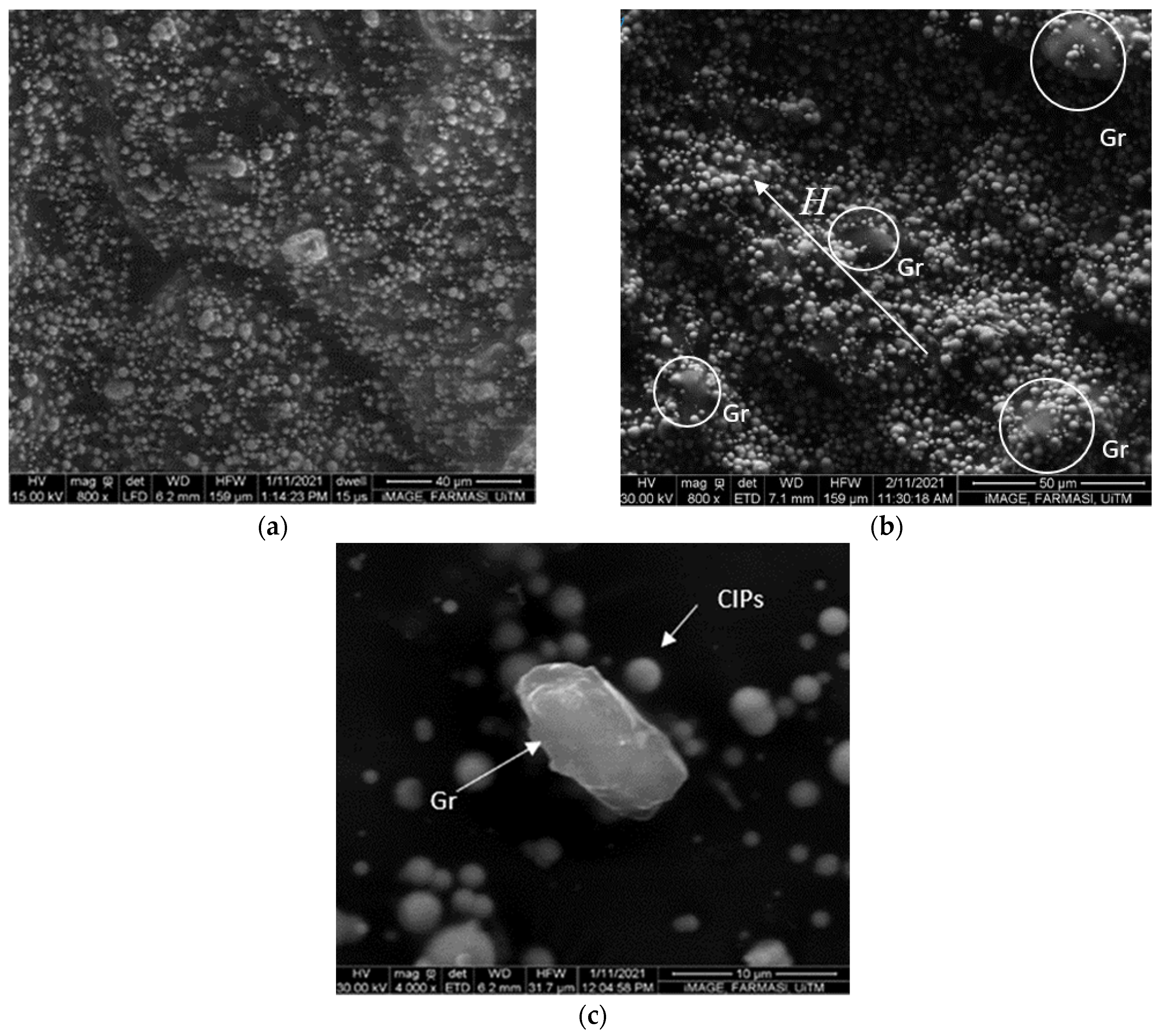
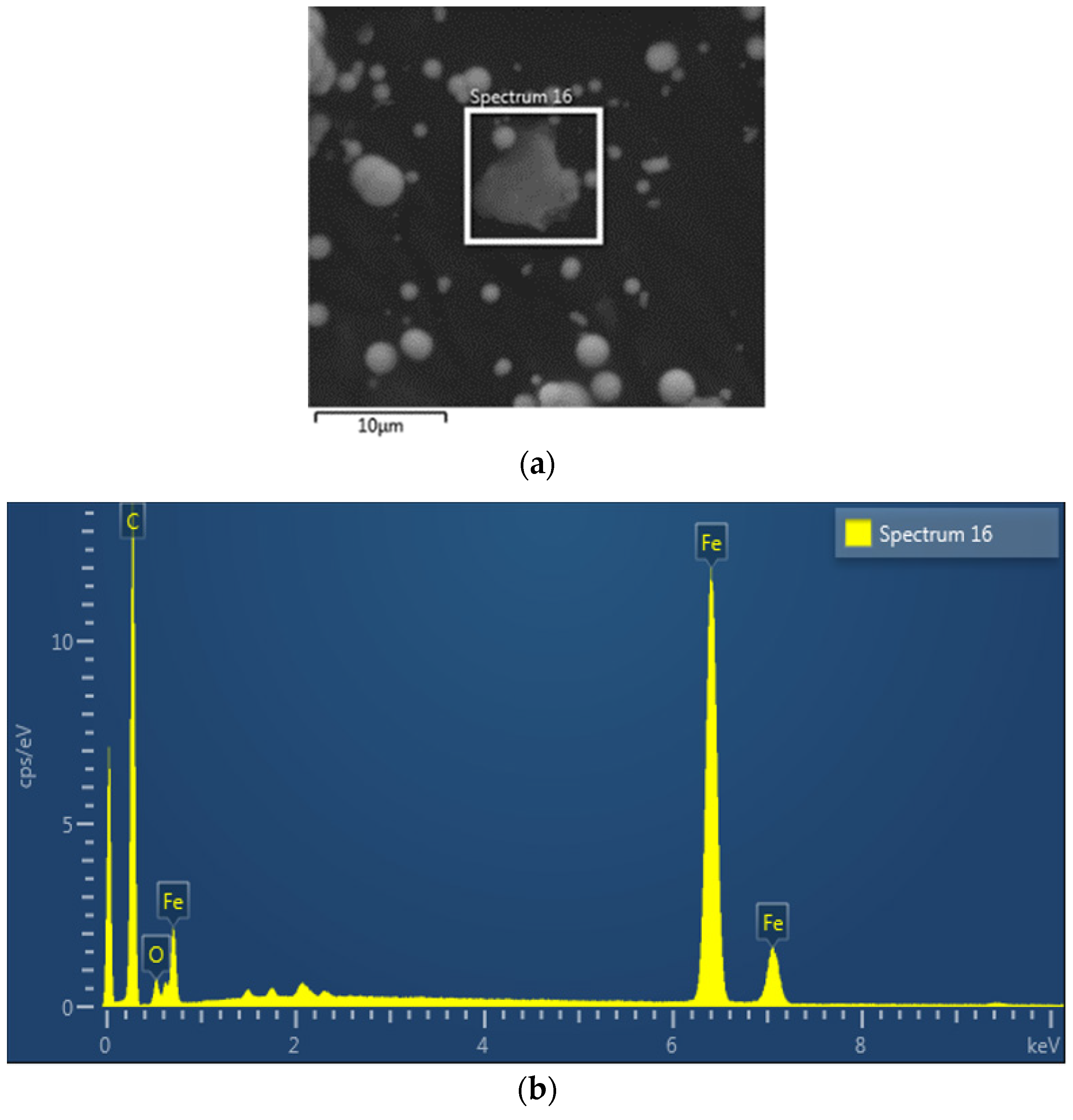
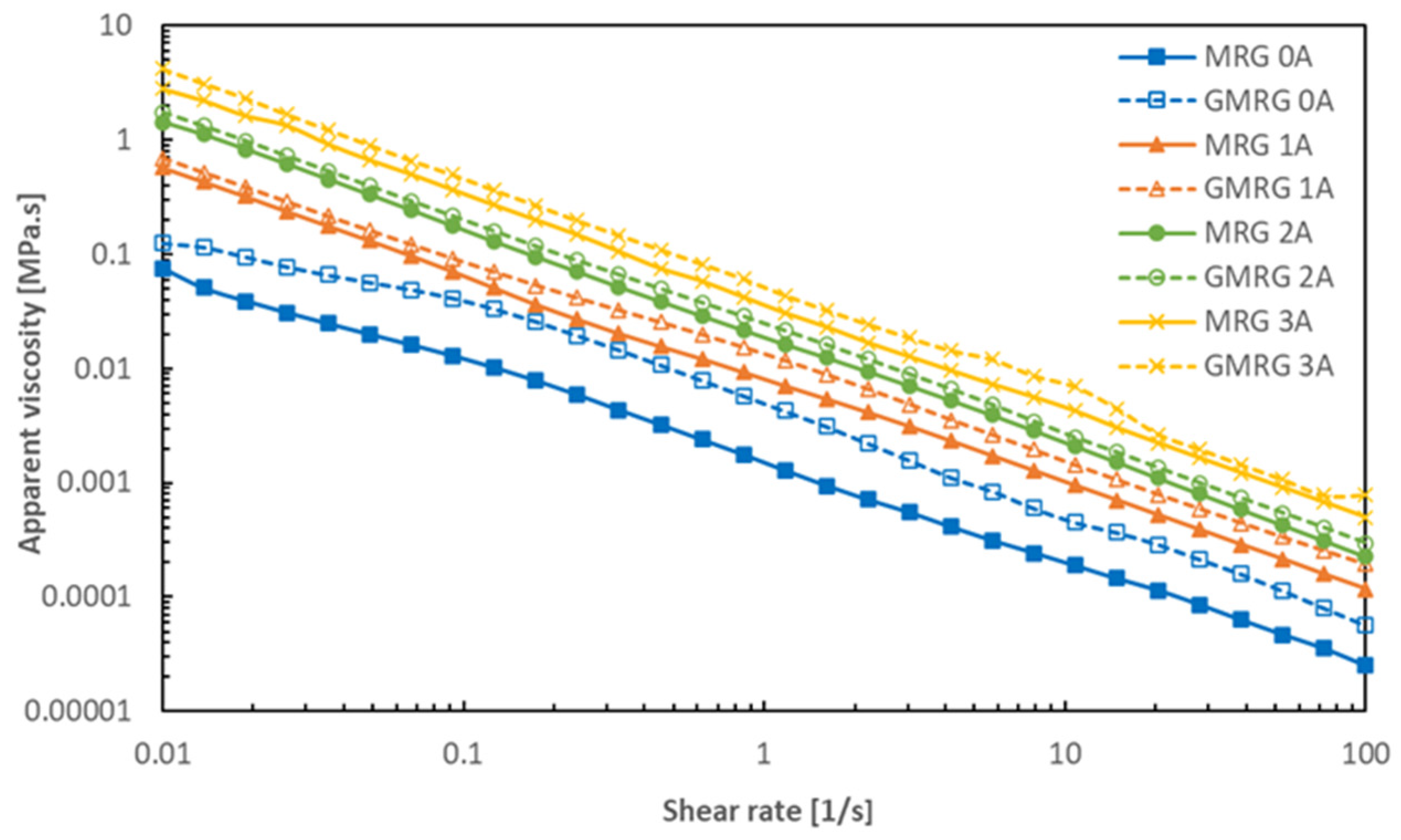
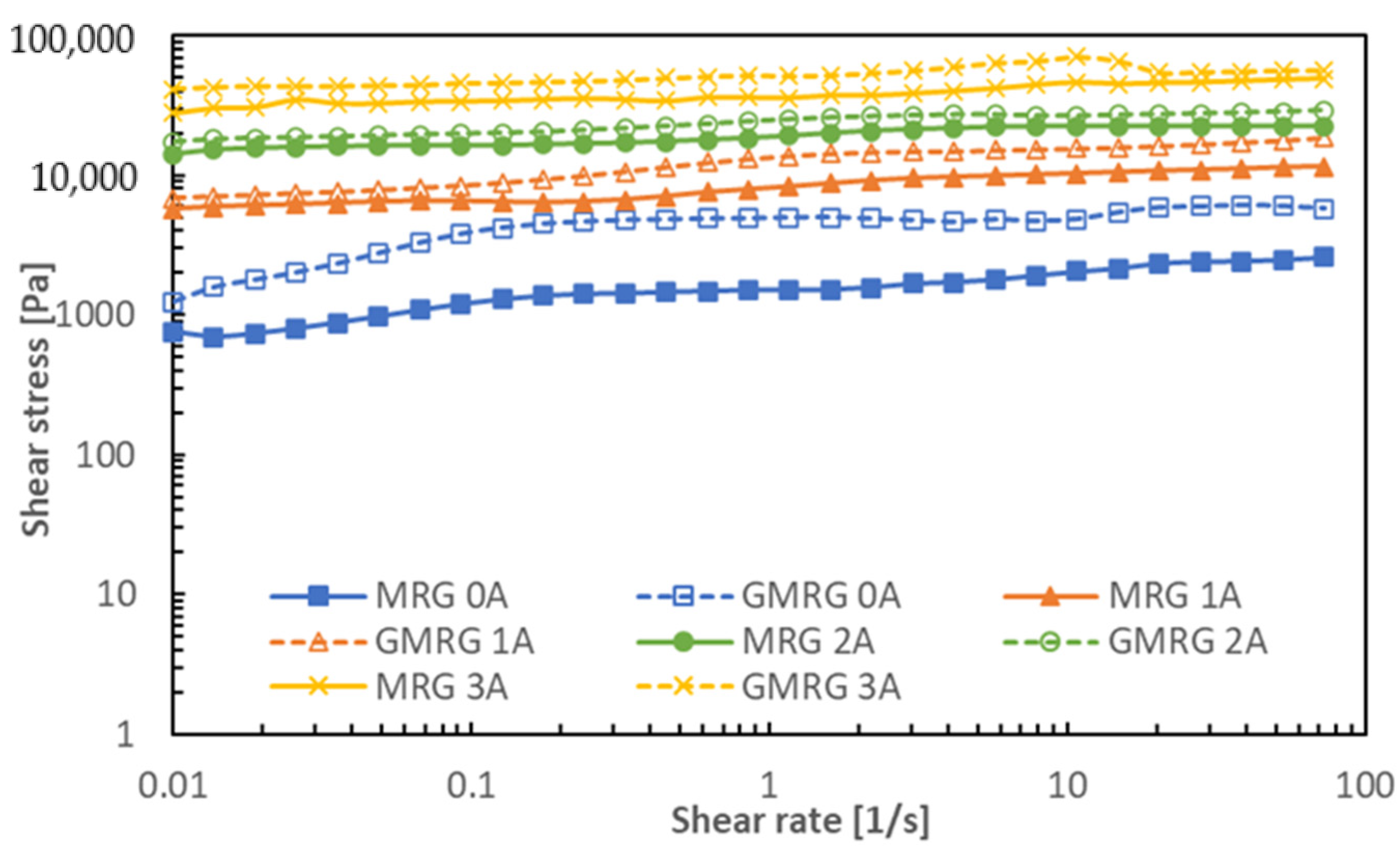
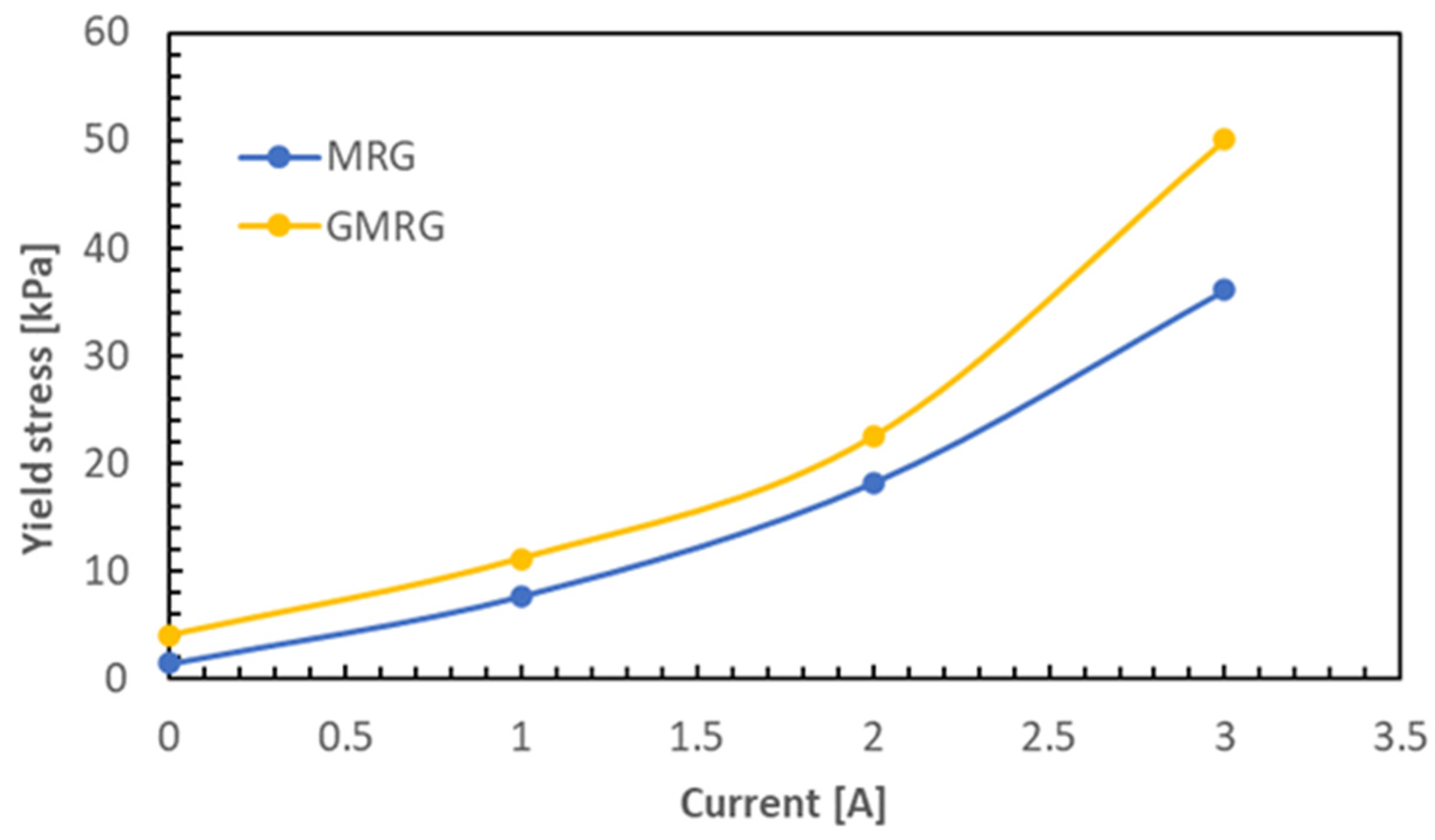
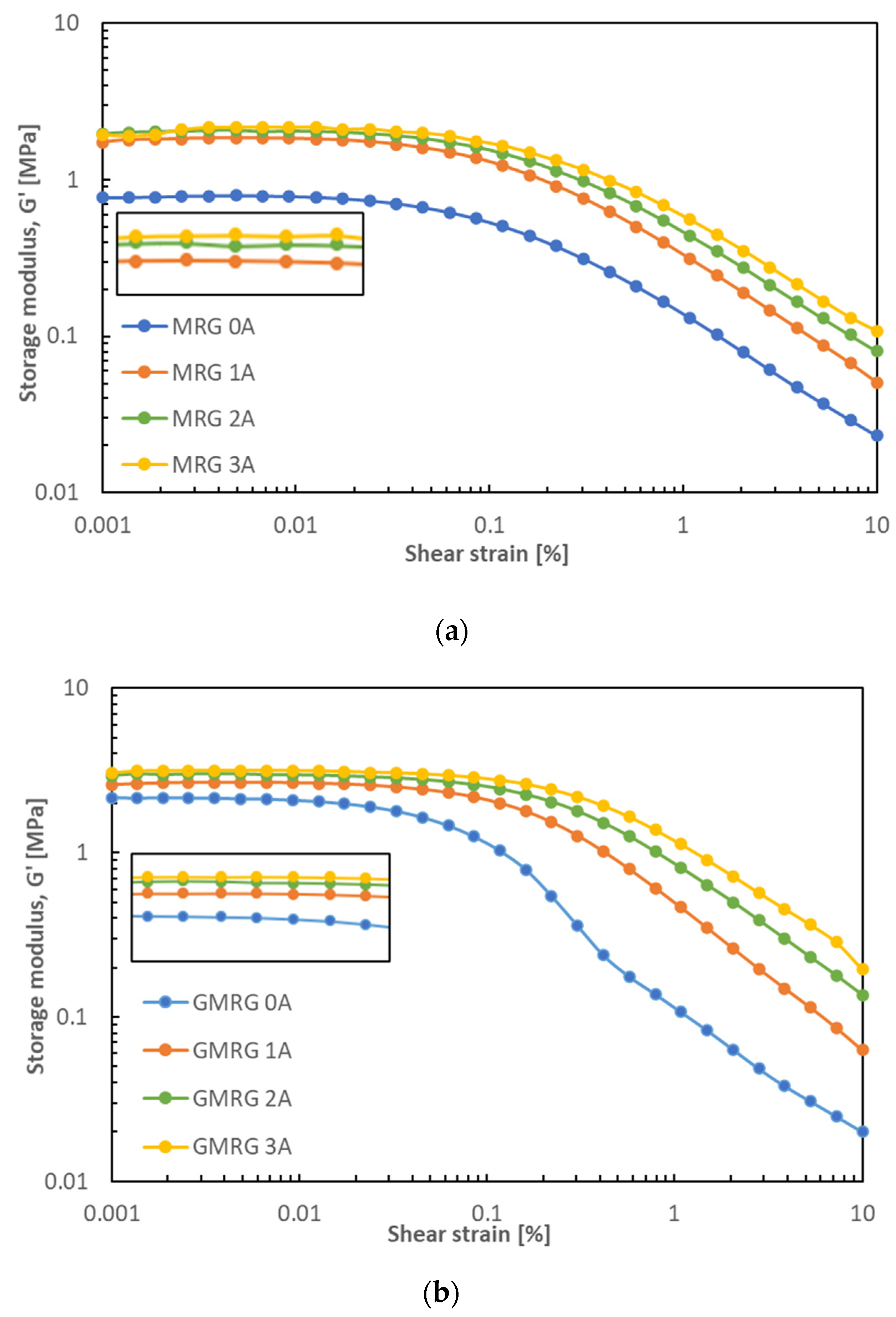
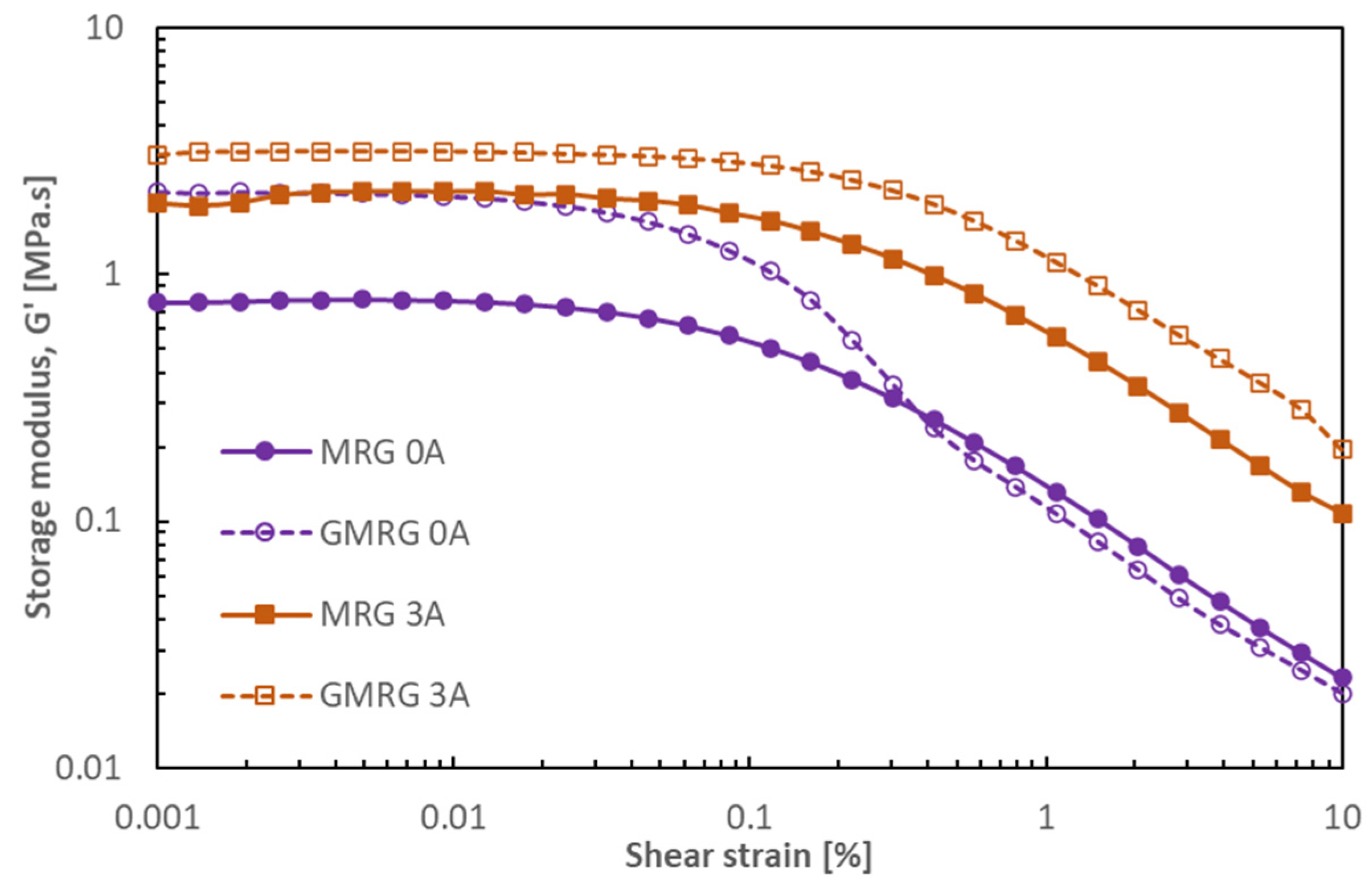
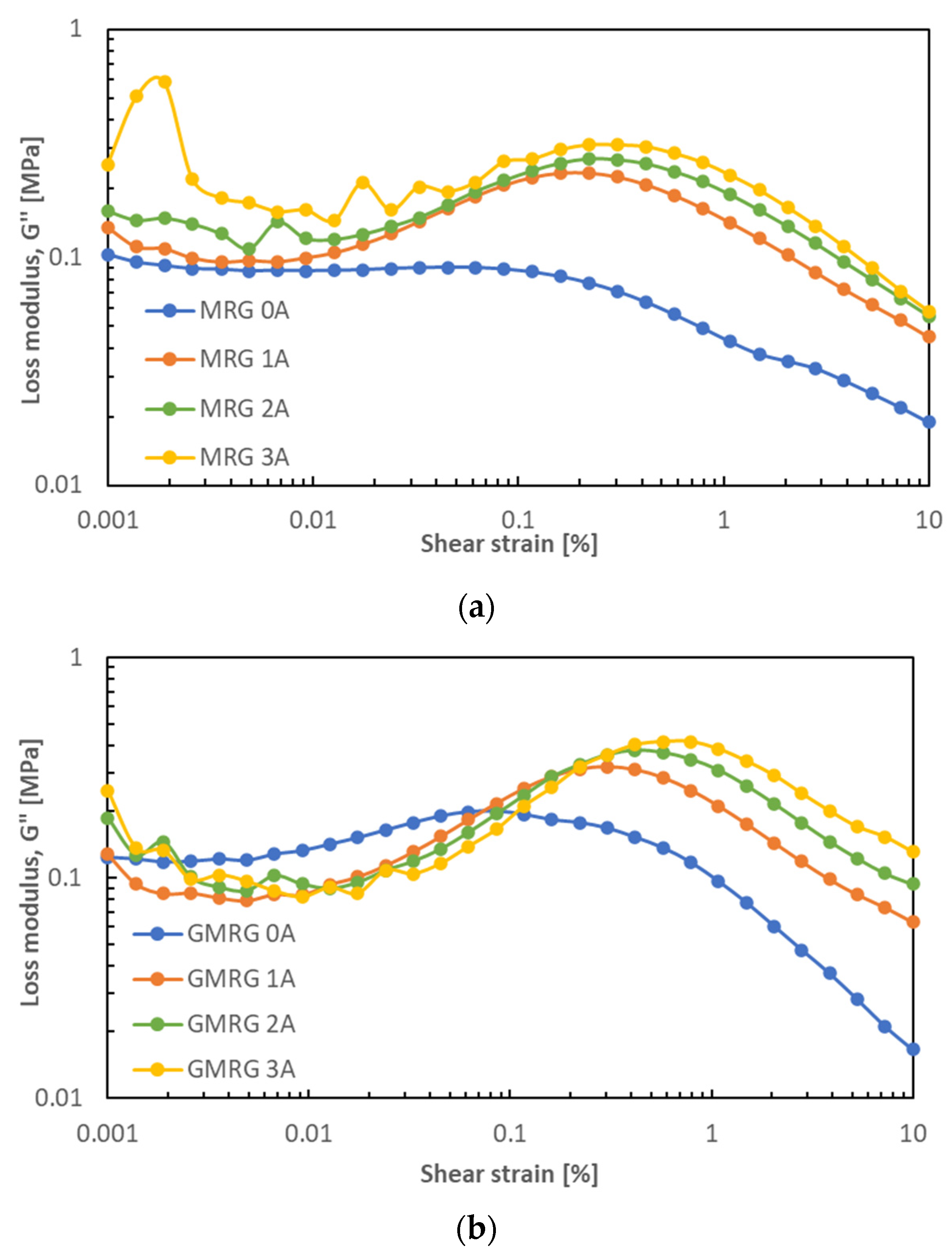
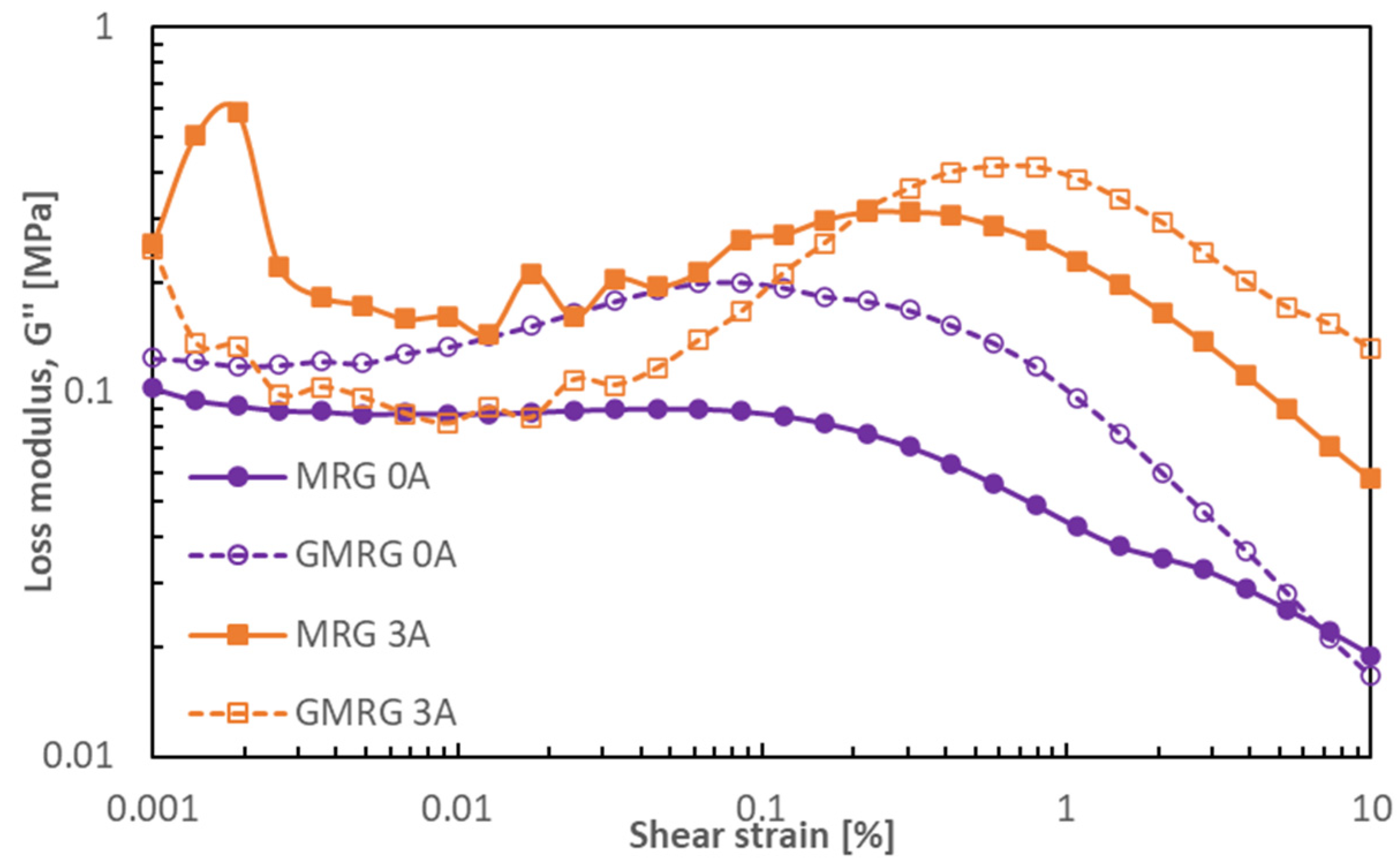
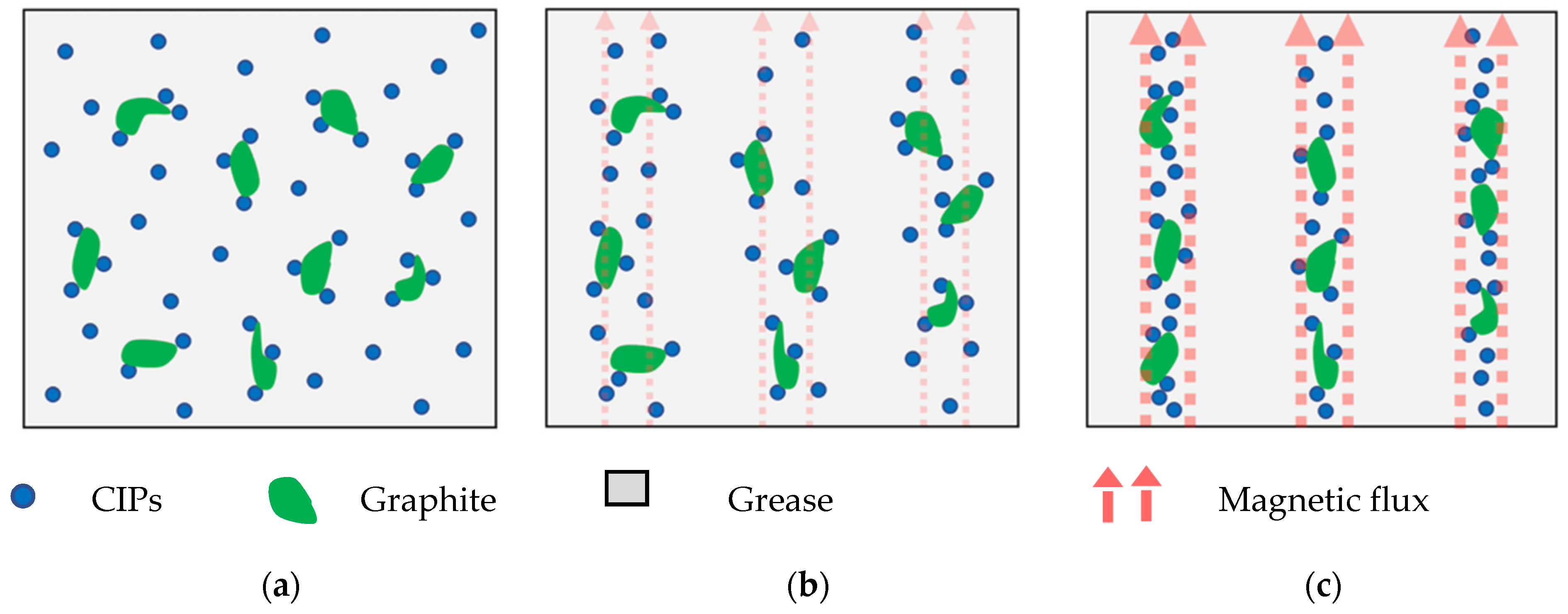
| Samples | Percentage by Weight (wt %) | ||
|---|---|---|---|
| Grease | CIPs | Graphite | |
| MRG | 30 | 70 | 0 |
| GMRG | 20 | 70 | 10 |
| Element | Weight (%) | Atomic (%) |
|---|---|---|
| C | 75.34 | 89.26 |
| O | 7.02 | 6.24 |
| Fe | 17.64 | 4.49 |
Publisher’s Note: MDPI stays neutral with regard to jurisdictional claims in published maps and institutional affiliations. |
© 2021 by the authors. Licensee MDPI, Basel, Switzerland. This article is an open access article distributed under the terms and conditions of the Creative Commons Attribution (CC BY) license (https://creativecommons.org/licenses/by/4.0/).
Share and Cite
Mohd Nasir, N.A.; Nazmi, N.; Mohamad, N.; Ubaidillah, U.; Nordin, N.A.; Mazlan, S.A.; Abdul Aziz, S.A.; Shabdin, M.K.; Yunus, N.A. Rheological Performance of Magnetorheological Grease with Embedded Graphite Additives. Materials 2021, 14, 5091. https://doi.org/10.3390/ma14175091
Mohd Nasir NA, Nazmi N, Mohamad N, Ubaidillah U, Nordin NA, Mazlan SA, Abdul Aziz SA, Shabdin MK, Yunus NA. Rheological Performance of Magnetorheological Grease with Embedded Graphite Additives. Materials. 2021; 14(17):5091. https://doi.org/10.3390/ma14175091
Chicago/Turabian StyleMohd Nasir, Nur Alyaa, Nurhazimah Nazmi, Norzilawati Mohamad, Ubaidillah Ubaidillah, Nur Azmah Nordin, Saiful Amri Mazlan, Siti Aishah Abdul Aziz, Muhammad Kashfi Shabdin, and Nurul Azhani Yunus. 2021. "Rheological Performance of Magnetorheological Grease with Embedded Graphite Additives" Materials 14, no. 17: 5091. https://doi.org/10.3390/ma14175091
APA StyleMohd Nasir, N. A., Nazmi, N., Mohamad, N., Ubaidillah, U., Nordin, N. A., Mazlan, S. A., Abdul Aziz, S. A., Shabdin, M. K., & Yunus, N. A. (2021). Rheological Performance of Magnetorheological Grease with Embedded Graphite Additives. Materials, 14(17), 5091. https://doi.org/10.3390/ma14175091








